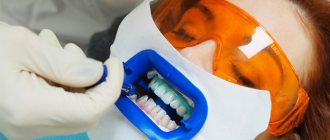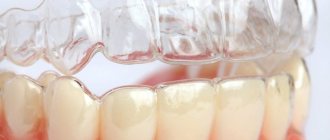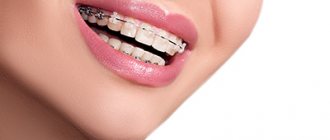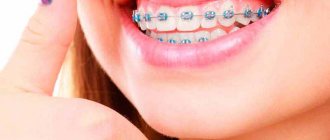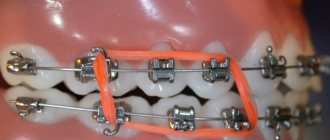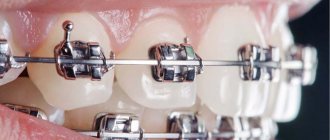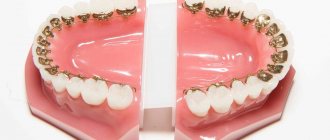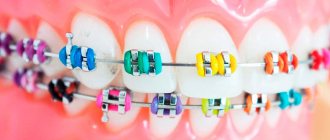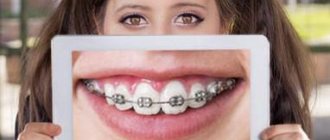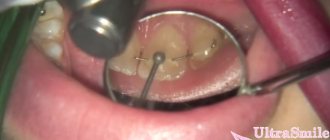3748
One of the most common and effective ways to correct bite defects is braces.
These structures are attached to each tooth and worn throughout the treatment period. An important role in the course of treatment is played by the correctness and reliability of fixation of the braces' locks.
Preparing for positioning
Installation of braces requires a preparatory stage. After an initial consultation with an orthodontist, the patient will need to carefully prepare the oral cavity.
Braces are installed only on healthy elements of the jaw arch.
Basic steps in preparation:
- Treatment of carious lesions. It is necessary to detect and treat all existing sites of caries development, even the smallest ones;
- Checking old fillings. If there are seals that were installed a long time ago, you need to check their strength and replace if necessary;
- Periodontal diseases. The mucous membrane of the oral cavity must be absolutely healthy. Even the most minor inflammations can worsen after the installation of braces;
- Remineralization. If there are areas of thinning enamel, increased sensitivity or cracks on the teeth, a remineralization procedure should be performed. It will help strengthen tooth enamel and avoid the development of certain diseases during orthodontic treatment.
Complete sanitation of the oral cavity is a prerequisite that must be completed first before installing braces.
Depending on the initial condition of the oral cavity, the preparation stage may take several months.
During the treatment period, panoramic photographs of the jaws . Based on them, the doctor draws up a treatment plan and determines where to fix the locks.
Immediately before fixing braces, it is necessary to have your teeth professionally cleaned . During this procedure, the surface of the teeth is cleaned, tartar and plaque are removed.
This is done to ensure that the surface of the teeth is absolutely clean, and when gluing the structure nothing interferes with the strong adhesion of the surfaces.
Why is it undesirable to undergo an MRI with braces on your teeth?
Come here if you are interested in what to do if a person accidentally swallows a brace.
At this address https://orto-info.ru/sistemyi-vyiravnivaniya-zubov/breketyi/nuzhno-li-udalyat-pri-ustanovke.html we will answer the question: is it necessary to remove teeth when installing braces.
Preparatory stage
To install braces, you need to complete preparation, which includes:
- initial appointment, performing a visual examination of the oral cavity;
- diagnostics, radiography and other studies to assess pathology and select the type of device;
- treatment of caries and other diseases, including inflammatory processes;
- replacing loose, old fillings;
- checking the condition of gum tissue;
- elimination of periodontal diseases;
- Carrying out office cleaning, removing soft and hard deposits;
- remineralization in order to protect tissues from caries and strengthen enamel before the upcoming procedure.
Sanitation is a prerequisite before starting corrective treatment. The device can only be placed on healthy rows, since damage to the coronal part, inflammation and other problems will reduce the effectiveness of therapy or make it impossible to install the device. It is also necessary to have a panoramic image to evaluate the jaws and the development of individual units. It is with the help of information obtained by this method that a treatment plan is drawn up and a method of attaching the braces is selected.
Direct method
After all the preparatory procedures have been completed, the doctor can begin fixing the bracket system. There are two main ways to attach braces to teeth – direct and indirect.
The direct method involves manually gluing clasps onto each tooth. This work is quite painstaking and requires a lot of attention and experience of a specialist.
To some extent, such work can be compared to jewelry. All teeth have different sizes, so the clasps must be precisely selected and glued.
During installation of the structure, the doctor uses tweezers, a clamp, a holder and a positioner. With their help, the orthodontist holds the clasps, measures their exact position in accordance with the marks on the panoramic photographs and fixes them on the teeth.
Sequence of actions for direct installation:
- A retractor is installed;
- A special composition based on orthophosphoric acid is applied to the enamel. It helps make the enamel surface rougher, which creates the most reliable adhesion;
- After 30 seconds, the composition is washed off with water;
- The surface of the teeth is dried;
- A therapeutic composite is applied to the enamel, which creates a protective layer;
- An adhesive composition is prepared (as a rule, it consists of two components);
- Glue is applied to the back of the locks;
- The lock is fixed to each tooth in turn;
- Excess glue is removed;
- After the glue has hardened, a metal arc is inserted and ligatures are attached.
The entire procedure for installing a bracket system takes approximately 1-1.5 hours. Complete hardening of the glue occurs in about a day.
During this period, the patient should take only soft and liquid foods.
The advantages of this method are:
- Accurate installation of locks according to the planned plan;
- Possibility of making adjustments during installation;
- Reliable fastening of locks;
- Prevents food from getting between locks and enamel.
The disadvantages are:
- Takes a long time;
- The patient must remain stationary throughout the entire installation;
- A lot of effort and attention is required from a doctor.
The video shows the process of the direct method of fixing braces.
Direct technology for fixing braces
This method of attaching a corrective structure involves attaching it specifically to each tooth. The doctor installs a dilator into the patient’s oral cavity that holds the cheeks, lips, and tongue. Thus, it isolates the dental units from the soft tissues. Each tooth is cleaned with dental paste and a brush. Then, one by one, the doctor applies a special composition containing phosphoric acid. The product is harmless, does not damage the enamel, and creates microscopic roughness, which is necessary for reliable fixation of braces. Next, the orthodontist applies an adhesive bond system to the teeth, and a composite material to the brackets. Then he presses the bracket onto the tooth and the assistant uses a lamp to illuminate the composite.
Among the advantages of the method, it is worth noting the possibility of correcting structures. The downside is that such fastening is labor-intensive, since the procedure lasts approximately an hour and a half. It is uncomfortable for the patient to keep his mouth open for such a long time. The doctor will have to perform a large amount of work in one visit.
Indirect installation
Recently, the indirect method of fixing braces has become popular. This method allows you to glue products to all teeth at the same time using a special tray.
The indirect method of fixing braces reduces the time of direct installation, but requires longer preliminary preparation in the laboratory.
What is the preparation:
- Impressions are taken of the patient's jaws , on the basis of which an accurate plaster model is made;
- The location of the locks is marked on the model using reference lines;
- Using burnt sugar or heating the model, the clasps are fixed to the jaw model;
- A special mouthguard is made that accurately follows the contours of the teeth;
- The mouth guard is pressed against the model , thereby transferring the locks onto it.
Installation of the structure to the patient is carried out as follows:
- A retractor is installed;
- Tooth enamel is etched with an orthophosphorus compound;
- After 30 seconds, the solution is washed off;
- The surface of the teeth is dried;
- A protective composite is applied;
- An adhesive is applied to the back of the locks;
- A mouthguard with braces is placed on the jaw;
- After an hour, the mouth guard is removed;
- A metal arc and ligatures are installed.
Among the advantages of this method are:
- Quick installation due to simultaneous gluing to all teeth;
- Comfort for the patient;
- Precision installation helps to avoid unnecessary pain and speeds up the treatment process.
The disadvantages are:
- It is difficult to determine the correct installation point;
- Inability to control the process of fixation on each tooth;
- It is difficult to remove excess glue;
- Long preparation process.
Watch the video to see how braces are installed indirectly.
Indirect technology for fixing bracket systems
This method differs from the previous one in that there is practically no need for the presence of the patient, which is very convenient for him. The procedure for fixing braces consists of the following steps:
- The orthodontist takes an impression, takes it to a dental technician in the laboratory, who makes an exact copy of the patient’s jaw - a plaster model, and covers it with an insulating varnish coating.
- For each tooth, the dentist attaches a bracket to a false tooth specifically in the position that is optimal for the patient. At the same time, the doctor can work as long as he needs, which allows him to attach dental structures to correct the dentition in a mode convenient for him.
- The doctor applies liquid hardening silicone to the bracket system, which is converted into a mouth guard. The braces and mouth guard are placed in water for 30 minutes, the varnish dissolves and the braces remain in the mouth guard.
The patient comes to see the dentist and he transfers the finished mouthguard into the oral cavity. Lighting and installation of braces is carried out in the required place.
One of the advantages of this method is the quick installation of braces. It will take no more than an hour to fix. There are also disadvantages, but few people pay attention to them, since the result is excellent. It takes time to make the model, mouthguard and system, this is the only drawback.
Thomas Pitts Table
The above methods of installing braces are based on the personal approach of the attending physician. In addition to this approach, a special protocol for fixing orthodontic systems has been developed.
This approach was developed and proposed by the American doctor Thomas Pitts. Pitts positions guarantee rapid correction of malocclusions.
For ease of understanding and use, these rules were translated by Dr. T. Castelanos into numerical parameters taking into account the length of the teeth.
The Pitts system consists of two parts and has the following scheme.
Upper jaw
| GPS-A | 1 | 2 | 3 | 4 | 5 | 6 | 7 |
| 8 | 4 | 4 | 4,5 | 4,5 | 4 | 3 | 3 |
| 9 | 4,5 | 4,5 | 5 | 5 | 4,5 | 3,5 | 3,5 |
| 10 | 5 | 5 | 5,5 | 5,5 | 5 | 4 | 4 |
| 11 | 5 | 5 | 6 | 6 | 5,5 | 4,5 | 4,5 |
Lower jaw
| GPS-A | 1 | 2 | 3 | 4 | 5 | 6 | 7 |
| 9 | 5 | 4,5 | 4,5 | 4 | 3,5 | 2,5 | 2 |
| 10 | 5,5 | 5 | 5 | 4,5 | 4 | 3 | 2 |
| 11 | 6,5 | 5,5 | 5,5 | 5 | 4,5 | 3,5 | 2,5 |
| 12 | 7 | 6 | 6 | 5 | 5,5 | 4 | 2,5 |
The installation location of the brackets is determined according to the following diagram:
- The length of the tooth crown is measured;
- The resulting figure is looked up in the GPS-A column;
- Next is the installation height according to the tooth standard.
This system helps to quickly determine the desired position for fixing braces, reduces installation time and reduces the likelihood of subjective errors.
Biomechanics of tooth movement
To understand how braces work, let’s look at the biological and physiological processes that occur during tooth movement. The teeth are located in the alveoli - natural depressions in the jaw bones of the skull. The root of each tooth is surrounded by periodontal fibers that hold the tooth in the socket. The fibers also perform a shock-absorbing function: they allow the tooth to make micro-movements in all directions. After fixing the bracket and installing the arch, force begins to act on the root of the tooth. To move teeth slowly and less painfully, a weak and prolonged force is applied.
Due to the movement of the tooth root, there is a need to free up space in the alveolus. To do this, osteoclasts begin to destroy the bone where the root touches the alveolar wall. Osteoclasts are special cells that remove bone tissue. On the opposite side, osteoblasts produce new bone to fill the vacated space. Under the influence of osteoclasts and osteoblasts, the balance of formation and destruction of bone tissue ensures the progressive movement of teeth.
Resilines adhesive system
The most popular adhesive for fixing braces is the Resilience system. Its adhesive is very soft and sticky, ideal for bonding braces. Using the composition, you can fix both metal and sapphire and ceramic products.
The adhesive hardens under the influence of light. Until the moment of illumination, it remains soft, which makes it possible to accurately install the lock.
The adhesive hardens completely when exposed to light. The metal arch can be installed immediately after fixing the locks.
The Resildynes system consists of several drugs. The cost of one set can vary between 10-15 thousand rubles.
The kit includes:
- Adhesive (in a syringe);
- Etching gel (in a syringe);
- Primer;
- Different tips for syringes;
- Palette for mixing components;
- Holder;
- Brush with three attachments of different lengths.
Is it possible to get a tax deduction for installing braces and what is needed for this?
In this publication, read which category of patients can count on having braces installed under compulsory medical insurance.
Here https://orto-info.ru/sistemyi-vyiravnivaniya-zubov/breketyi/ormco.html we will look at Ormco metal braces in detail.
Construction of braces: comparison of non-ligating and self-ligating structures
There are ligature and self-ligating devices. The first includes traditional designs: the arc is fixed in the groove using elastic or wire ligatures. Example: Mini Diamond, Inspire Ice, Orthos devices. Ligature systems are characterized by a long treatment period - from one to three years, depending on the complexity of the clinical case, lengthy adaptation and labor-intensive hygienic care. Activate the device: replace arches and ligatures, it is necessary on average once a month, and sometimes more often.
traditional construction with ligatures
ligature Mini Diamond
The design of self-ligating braces has a fundamental difference: the system works without ligatures. Consists of a groove and a closing lid. The orthodontic arch slides in the groove. Ligature-free designs provide a reduction in treatment time compared to ligature devices by an average of 7 months. Less painful during the adaptation stage and easier from the point of view of oral hygiene. They turn out to be the option of choice in many clinical cases. The entire line of Damon System braces are self-ligating.
self-ligating Damon Q2
How does a braces system without ligatures work? The principle of operation of non-ligation devices is divided into passive and active self-ligation. With the passive type of fixation, the arc moves freely in the groove. The cover holds the arc and does not put pressure on it. Example: Damon Q, Damon Clear. With the active type of self-ligation, the clip presses on the arch and moves it to the base of the groove. Activation of self-ligating systems is carried out once every 2-3 months.
system without ligatures
Damon Clear and Q on typodont
Braces are made from various materials. Ligature and self-ligating structures are made of metal, transparent polycrystalline aluminum (ceramics), plastic and artificially grown sapphire. Metal braces, for example, Damon Q and Damon 3 MX, are the most durable. The Damon Clear2 ceramic and sapphire Inspire Ice models have the best aesthetic characteristics.
metal Damon Q2
ceramic Damon Clear
The orthodontist and the patient jointly overcome the path to high aesthetic smiles and a healthy dental system. Regardless of the type of braces and manufacturing material, the combination of the orthodontist’s professionalism with a high degree of patient responsibility allows one to achieve stable results in the treatment of malocclusions.
Price issue
In many dental clinics, the cost for installing braces is highlighted as a separate line.
But there are also clinics where the amount for fixing the orthodontic system is included in the total cost of manufacturing the system. On average, this service is estimated at approximately 30% of the total cost of the braces system.
The installation price for products made from different materials will vary. The more expensive the system itself, the more expensive it will cost to install.
| Product material | Direct installation amount, rub. |
| Metal | From 10 000 |
| Ceramics | From 18000 |
| Sapphire | From 25000 |
The direct method is the most common installation method. The indirect method is currently used in a limited number of clinics. This is explained by its novelty and limited experience of specialists.
Due to the need to make a plaster model and special trays with the indirect method, its cost will increase by approximately 6-9 thousand rubles, compared to the direct method for each type of product material.
Useful tips
Correcting a bite with braces can take a long period of time. The speed and result of correction of defects depends on how accurately the patient follows all the doctor’s recommendations.
For the first time after fixing the orthodontic system, the patient should avoid solid foods and increased load on the jaws. Preference should be given to soft or liquid foods.
In the future, you must follow these recommendations:
- Visit your doctor regularly. This is necessary to assess the condition, adjust the pressure on the teeth, change ligatures and make the necessary adjustments;
- Careful oral hygiene. It is necessary to brush your teeth several times a day, after eating food. If there are no conditions to brush your teeth, you must rinse your mouth thoroughly;
- Use additional hygiene products (irrigator, floss, brush, etc.);
- Adhere to a special diet. The patient should exclude foods that are too hard, sticky or tough from the diet;
- Carry out periodic professional teeth cleaning;
- Eliminate bad habits.
Following these recommendations will help speed up the treatment process and will also reduce the likelihood of parts of the system coming off or being damaged.
Invisalign clear aligner system
Another system that allows you to find out the final result of orthodontic treatment is Invisalign . A unique system of transparent aligners that are sequentially placed on the teeth and gradually straighten them.
Visualization of the treatment result, as well as the process of tooth movement, are recreated on a computer, similar to Insignia technology. The stages are the same: scanning, set-up modeling, approval by the doctor and the patient, manufacturing a set of aligners. The Invisalign aligner system is designed and manufactured in the USA.
In each case, you can evaluate the final result of orthodontic treatment, obtaining a completely individual system for teeth alignment and bite correction.
Indirect fixation of braces, individual Incognito lingual braces, computer-modeled vestibular braces using Insignia technology (CAD/CAM), Invisalign clear aligners - which option you choose is up to you.
You can obtain more detailed information about systems of individual braces and mouth guards by scheduling a consultation with the orthodontist at Atribeaute Clinique - Anastasia Olegova Fedorova.
